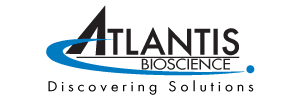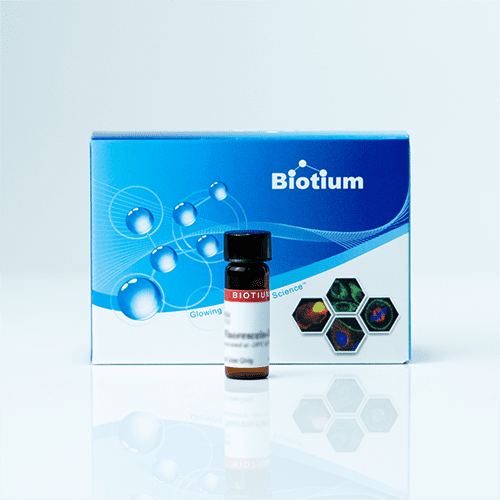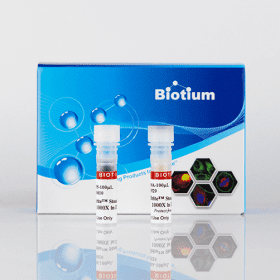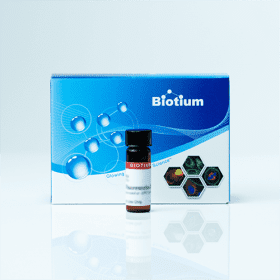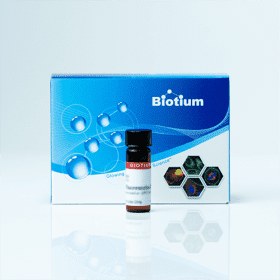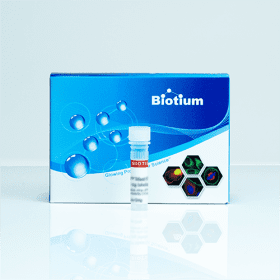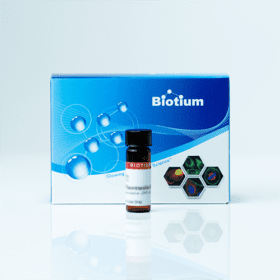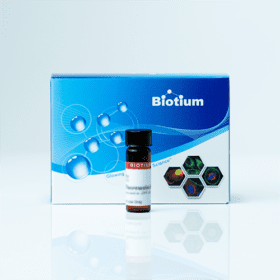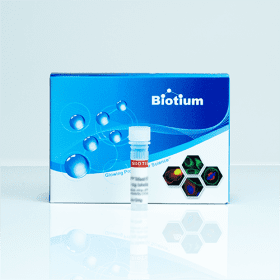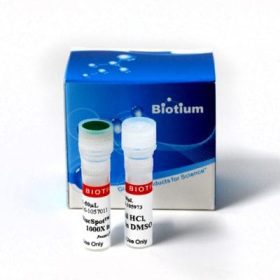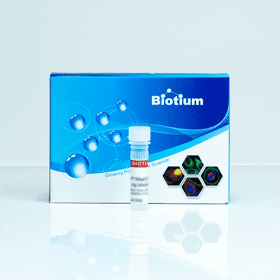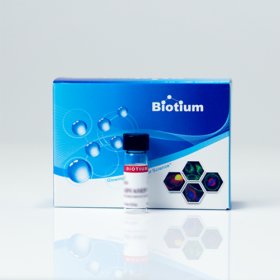Biotium products are distributed only in Singapore and Thailand.
Deepen Your In Vivo Imaging: DiR – Near-Infrared Cytoplasmic Membrane Stain
Biotium’s DiR stain offers exceptional performance for labeling cytoplasmic membranes in live and fixed cells. This lipophilic, near-infrared fluorescent cyanine dye is ideal for researchers seeking high-quality in vivo imaging applications.
Unparalleled Advantages of DiR:
Deep Tissue Penetration: Near-infrared fluorescence minimizes background noise and enables visualization of cells deep within tissues for superior in vivo imaging.
Specific Cytoplasmic Membrane Labeling: The two C18 hydrocarbon chains target cell membranes, resulting in clear and specific staining with minimal signal from other cellular compartments.
Live Cell Compatible: DiR can be used with both live and fixed cells, providing versatility for your research needs.
Long-Lasting Signal: The dye exhibits exceptional photostability, ensuring reliable signal retention during extended imaging experiments.
Minimal Cell Transfer: DiR minimizes dye transfer between cells, leading to cleaner data and more accurate image analysis.
DiR Applications:
- In vivo imaging of cell trafficking and migration
- Long-term live cell imaging of membrane dynamics
- Colocalization studies with other fluorophores
- Studying cell viability and proliferation
| 5 x 1 mg | #60017-5mg |
|---|---|
| 10 mg | #60017-10mg |
Technical Specifications
CAS number: 100068-60-8
Probe cellular localization: Membrane/cell surface, Membrane/vesicular
For live or fixed cells: For fixed cells, For live/intact cells
Fixation options: Permeabilize before staining, Fix after staining (formaldehyde), Fix before staining (formaldehyde)
Colors: Near-infrared
Excitation/Emission: 748/780 nm
λEx/λEm (MeOH): 748/780 nm
Extinction Coefficient (ε): 270,000
Appearance: Dark blue-green oily solid
Solubility: Ethanol, DMF, DMSO
Storage: 4°C, protected from light
FAQs
Q1: My product was accidentally left out at room temperature or exposed to light. Is it ruined?
A1: Most of our products are stable at room temperature for many days, so in all likelihood the product will still work just fine. To be on the safe side, we recommend performing a small scale positive control experiment to confirm that the product still works for your application before processing a large number of samples or precious samples.
Q2: Where can I find the expiration date or shelf life of a product? Is the product still good if I have had the product longer than the guaranteed shelf life?
A2: Biotium guarantees the stability of chemicals, dyes, and gel stains for at least a year from the date you receive the product. However, the majority of these products are highly stable for many years, as long as they are stored as recommended. Storage conditions can be found on the product information sheet or product safety and data sheet, material safety data sheet, and on the product label. Fluorescent compounds should be protected from light for long term storage.
If you have a Biotium compound that has been in storage for longer than one year that you wish to use, we recommend performing a small scale positive control experiment to confirm that the compound still works for your application before processing a large number of samples or precious samples.
Q3: My product arrived at room temperature or thawed, but it’s supposed to be stored at 4°C or -20°C. Is it still ok?
A3: Most of our products are stable at room temperature for many days, but we recommend storage at 4°C or -20°C to prolong shelf life. In the case of many of our aqueous dye solutions, the compounds are very stable at room temperature, but we recommend cold storage to prevent the growth of mold or other microbes over time. Therefore, to save on shipping costs, products with recommended storage at 4°C or -20°C may ship at ambient temperature or with an ice pack. These products may thaw without affecting product performance. When you receive the product, place it under the recommended storage conditions.
Some products are shipped with blue ice packs as an extra precaution against high temperatures. The blue ice packs may be thawed upon arrival without affecting product performance.
Products with recommended storage at ultra low temperature (-70°C) that also ship on dry ice should arrive frozen. If a product you received was shipped on dry ice and thawed during transit, please contact customer service at [email protected]
Reference Publications
Sang, M. M., Liu, F. L., Wang, Y., et al.
A novel redox/pH dual-responsive and hyaluronic acid-decorated multifunctional magnetic complex micelle for targeted gambogic acid delivery for the treatment of triple negative breast cancer
Drug Delivery, 25(1), 1846–1857
DOI: https://doi.org/10.1080/10717544.2018.1486472
Article Snippet: “1,10-Dioctadecyl-3,3,3,3-tetramethyl indotricarbocyanine iodide (DiR), near-IR lipophilic carbocyanine dye, whose absorption and emission wavelengths were 748 nm and 780 nm obtained from Biotium Inc. (Hayward, CA).”
Dang Wenli, Guo Pan, Song Xunan, et al.
Nuclear Targeted Peptide Combined With Gambogic Acid for Synergistic Treatment of Breast Cancer
Frontiers in Chemistry, Volume 9, 2022
DOI: 10.3389/fchem.2021.821426
Article Snippet: “1,10-Dioctadecyl-3,3,3,3-tetramethyl indotricarbocyanine iodide (Dir) was purchased from Biotium Inc. (Hayward, CA);”
Spatarelu C-P, Van Namen A, Jandhyala S, Luke GP.
Fluorescent Phase-Changing Perfluorocarbon Nanodroplets as Activatable Near-Infrared Probes
International Journal of Molecular Sciences. 2022; 23(13):7312.
DOI: https://doi.org/10.3390/ijms23137312
Article Snippet: “The fluorophore, 1,1′-dioctadecyl-3,3,3′,3′-tetramethylindotricarbocyanine iodide (DiR, Biotium, Fremont, CA, USA), was pre-dissolved in chloroform and added to the lipid and Epolight mixture.”
Burand AJ Jr, Boland L, Brown AJ, Ankrum JA.
A Low-Cost Technique for Intraoperative Imaging of Cell Delivery and Retention in a Model of Delayed Wound Healing
Advances in Wound Care. 2017 Dec;6(12):413-424.
Article Snippet: “MSCs were lifted with accutase, washed in PBS, and incubated with DiR dye (Biotium) diluted to 0.1 mg/mL in media for 20 min at 37°C.”
Sun S, Sun S, Sun Y, Wang P, et al.
Bubble-Manipulated Local Drug Release from a Smart Thermosensitive Cerasome for Dual-Mode Imaging Guided Tumor Chemo-Photothermal Therapy
Theranostics 2019; 9(26):8138-8154
DOI: 10.7150/thno.36762
Article Snippet: “1,1′-Dioctadecyl-3,3,3′,3′-tetramethylindotricarbocyanine iodide (DiR) and DOX were obtained from Biotium”
